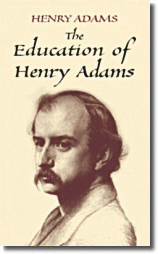
Aptly enough, he opens with Henry Adams, grandson and great-grandson of presidents:
Most so-called Washington novels are short on local history or geography. As a rule, the children of officialdom are taught to pretend the city isn't there. They love it, of course, the way a monkey in the zoo loves its wire-and-carpeting mom -- because it's there. But it's a doubtful, embarrassed kind of love.
Henry Adams, a Bostonian who started visiting Washington in 1850, when he was 12, records this feeling in his autobiography, The Education of Henry Adams (1907). He can't explain why he loves this place the grown-ups despise: "The May sunshine and shadow had something to do with it; the thickness of foliage and the heavy smells had more; the sense of atmosphere, almost new, had perhaps as much again; and the brooding indolence of a warm climate and a negro population hung in the atmosphere heavier than the catalpas."
I remember the first time I read this sentence -- I was 15, it was summer, the catalpas were stinking -- because even though I grew up in the District, and so had my father before me, I'd never read or heard anyone mention that the city had any physical charm to speak of, only that it was hot.
Adams grew up to write -- anonymously -- what is still the great Washington novel, Democracy (1880). The heroine, a young society widow named Madeleine Lee, falls under the spell of a powerful Illinois senator with a shady past. If you're going to read one novel about improper campaign contributions, read Democracy. Readers who know Adams through Education and his histories won't recognize him here.
Another politically-connected writer gets a nod as well: Gore Vidal, grandson of a senator from Oklahoma:
There has never been a Washington novel of ideas. These are books about careers, money and sex -- usually in that order.
Sometimes sex comes second, of course. Take, for example,
Gore Vidal's Washington, D.C. (1967), a multigenerational orgy of depravity set during the 1940s and '50s in "the estates that ringed the city, the Italianate palaces on Massachusetts Avenue, the small restored houses in the Georgetown slums which had lately become fashionable," a world Vidal knows from growing up there.
Washington, D.C. traces the rise of the handsome, amoral Clay Overbury, who is destined to be the first media president. (JFK's name is never mentioned.) As Overbury casually claws his way to the top, other thinly veiled public figures betray their wives and husbands, pimp their daughters, sleep with their siblings and sell out their best friends. Vidal's Washington is camp on the level of the Capitol Dome or the Washington Monument at cherry blossom time -- grand, absurd and disarmingly alive.
The Man Who Loved Children (1940) by Christina Stead is Stein's pick for "a great coming-of-age novel." This book was previously mentioned here on the blog.
As has the work of George Pelecanos:
he's the one novelist I know who has made it his business to chronicle the city as a whole. Over the course of 12 books, and as many murder investigations (most recently The Night Gardener), Pelecanos has traced the history of D.C. since World War II, when the papers first christened the city "Murder Capital."Pelecanos takes the convention of the salt-and-pepper detectives seriously -- he gets at what it's really like, and why it's really complicated, for blacks and whites to share each other's
space in the District. And his books chart the disappearance of this shared space -- to white flight, poverty, black flight and gentrification. Pelecanos writes with fetishistic attention to real-life details, as if he expected lunch counters, record shops and nightclubs to be rebuilt from his descriptions. Sometimes the main point of an interrogation seems to be getting his reader inside a favorite local bar -- back when it was still good. Sometimes his characters launch into earnest mini-lectures on the crack epidemic of the '80s, or a history of hardcore or go-go -- the way a Balzac character will launch into an outline of paper manufacture when he's supposed to be proposing marriage -- but this should only recommend Pelecanos to visitors who want to see beyond the Capitol and the Mall, who want to notice more than the heat.
Among the other books that rate for Stein: Larry McMurtry's Cadillac Jack, William Peter Blatty's The Exorcist, Andrew Holleran's Grief, Paul Kafka's Dupont Circle, "Ann Beattie's irresistible first novel" Chilly Scenes of Winter, and the linked story collections of Edward P. Jones, Lost in the City and All Aunt Hagar's Children.
Click here to read Stein's essay.
Other items in Salon's literary guide series include:
A literary guide to Vancouver
A literary guide to Baltimore
A literary guide to Argentina
A literary guide to Afghanistan
A literary guide to Louisiana
A literary guide to Australia
A literary guide to Norway
A literary guide to Turkey
A literary guide to Japan
A literary guide to Martha's Vineyard
A literary guide to West Texas
A literary guide to Togo
A literary guide to Brooklyn
A literary guide to Miami
--Marshal Zeringue






